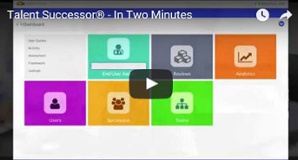How do I introduce robust
Succession Planning?
First things first. What is succession planning – and what does it mean in your organisation? It means different things to different people - and different succession planning models and processes weave throughout organisations.
Essentially Succession Planning is the process of identifying and developing potential future leaders or senior managers, as well as individuals to fill other business or critical positions, either in the short- or the long-term. [Source: Chartered Institute of Personnel and Development (CIPD)].
The benefits of succession planning are clear. You'll be minimising business risk, be able to more accurately plan for the future and be able to offer career progression for your strong talent.
But how do you get started? What are the key steps to take? Read on.
Step 1: Make sure you and the organisation are ready for succession planning
Whether you intend to roll out succession planning focusing solely on leadership and senior positions, or whether you want to take a more inclusive view and extend the process to a wider range of key roles, it’s hard to know where to start.
From our work with clients and succession planning best practice, we know that there are 5 key areas for you to take a look at within your organisation to help you decide if you're ready to implement effective succession planning. And you will want to check out what these are.
Step 2: Understand what you need to do within succession planning
You know the importance of succession planning. But do you know what are the key elements of succession planning? You need to find out before you go any further!
Step 3: Identify the critical roles
To decide which are the critical roles for which you need succession planning, you need first to understand the business strategy - inside out.
It's a good idea to also understand the jobs market: how readily available is the talent you need within your organisation? But don't just talk to your leaders about this. Expand this and talk to managers and specialists - and consult with the business about what you are intending to do.
Step 4: Decide how to identify successors
This might involve analysing the target roles so you can better understand the knowledge, skills, behaviours, experience and competencies needed. You may want to look at how to determine early markers of potential for success. And developing an assessment process aimed at determining who currently demonstrates the ‘potential criteria’. Make use of 360 degree feedback for your succession planning if you have it in place.
Step 5: Decide on a succession planning template to use
There is no one clear succession planning template that all organisations use. In our travels we see a range of succession planning approaches and succession planning templates. The most usual elements that get included are: geographic mobility (that is, the desire or availability to work in a different location); functional mobility; flight risk; potential and performance.
In addition, there is often also an attempt to gather career aspirations; individual strengths and weaknesses; competence scores.
All these elements all make complete sense – although the reliability of the data can be called into question if it’s stored on spreadsheets, rarely updated and there is no common, single succession planning system to access.
But more evolved succession planning templates also include an assessment of a ‘talent category’ (often associated with a 9 box grid or a Performance/Potential grid).
Step 6: Create the talent pool
Talent pools are a database of people who could effectively fill your current critical posts - so it's important to identify these critical posts. When you build your talent pool, you will want to include the top talent in your organisation and those you simply want not to lose. That is, the people who really make a difference to the organisation.
Step 7: Set up Talent Reviews. Define how these will run. Make sure they are free from bias
The Talent Review meeting or Talent Review Board is attended by the senior talent decision makers and relevant leaders and managers from the business. There are four main components to a talent review meeting. The assessment of the individual, the use of the 9 Box Grid, the discussion and the follow up. And you need to make sure that the meetings are free from bias. We know that there are key things that you can do in this process to make your talent review meeting more robust and improve your succession planning.
Step 8: Engage, communicate and feedback
Build a communications strategy into your succession planning. You will want to engage regularly with your talent (both those in the identified talent pool - and those not in the talent pool). It's also important to feedback to everyone following the Talent Review meeting and to keep everyone in the Talent Pool up to date.
Step 9: Keep in mind the changing 'demands' from Talent
There is much talk about Generation X and Y - and their different perspective on employment, working and reward. They have become consumers of organisations, just as the external customers or clients. How does this consumerisation of talent, impact succession planning? - and what will you do about it?
Step 10: Find succession planning software to support you. Talent Successor works well!
Not surprisingly, technology has transformed how succession planning is carried out. If you're going to implement robust succession planning, then you need succession planning software or a succession planning tool to support you - and you need it to be able to access and cut the data in whatever way you want.
Make sure you can answer the questions asked of you: where are there gaps in the succession plan? what posts have no successor in place? who is ready for their next career month in the next 6 months?....
But there are also some fundamental questions you need to ask of your succession planning software provider.
It you want to take a look at how a cloud-based succession tool can work, watch the short video below. Or read about more about Talent Successor when you're ready to see for yourself how it could work for you, get it touch.

